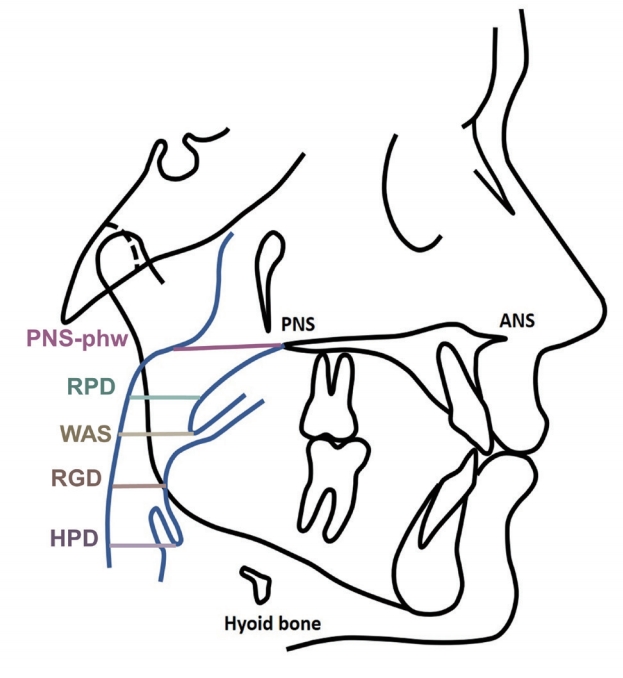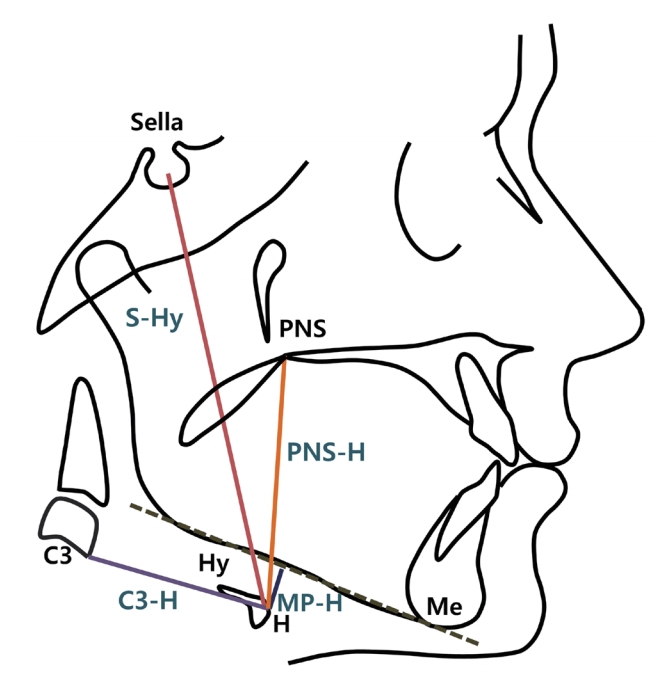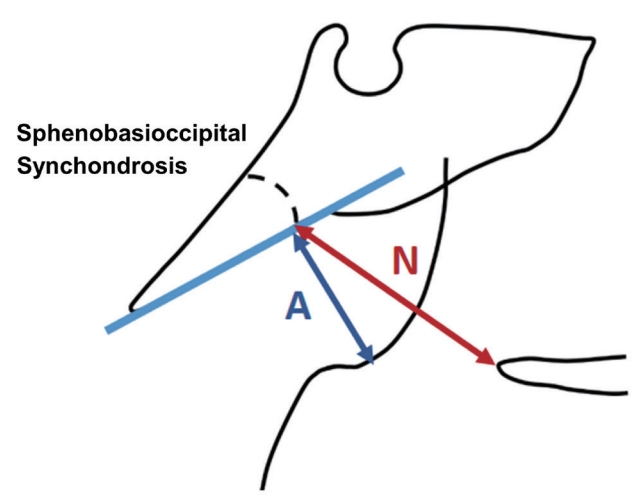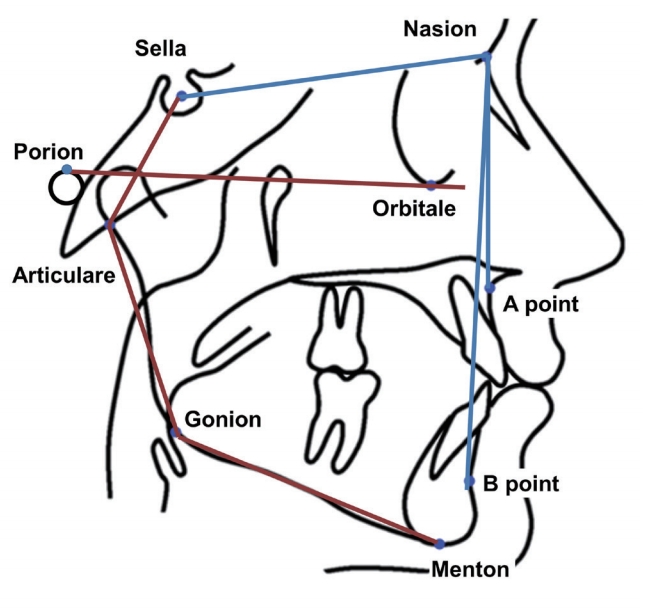ŌģĀ. ņä£ ļĪĀ
ņłśļ®┤ĒśĖĒØĪņןņĢĀ(Sleep disordered breathing, SDB)ļŖö ļÜ£ļĀĘĒĢ£ ņ¦łļ│æņØ┤ ņĢäļŗī, ņāüĻĖ░ļÅä ņĀĆĒĢŁņØś ņ”ØĻ░ĆņÖĆ ņØĖļæÉļ▓Į ļČĢĻ┤┤ņŚÉ ļö░ļźĖ ņĮöĻ│©ņØ┤ļéś ĒśĖĒØĪļĀźņØś ņ”ØĻ░ĆļĪ£ ņØĖĒĢ┤ ņłśļ®┤ņ£Āņ¦ĆņŚÉ ļ¼ĖņĀ£Ļ░Ć ļ░£ņāØĒĢśļŖö ĒśĖĒØĪņןņĢĀ ņ¦łĒÖśņØä ĒåĄņ╣ŁĒĢ£ļŗż[
1]. SDBļŖö ņāüĻĖ░ļÅä ņןņĢĀņØś ņŗ¼ļÅäņŚÉ ļö░ļØ╝ ņØ╝ņ░©ņä▒ ņĮöĻ│©ņØ┤(primary snoring), ņāüĻĖ░ļÅä ņĀĆĒĢŁņ”ØĒøäĻĄ░(upper airway resistance syndrome), ĒÅÉņćäņä▒ ņłśļ®┤ ļ¼┤ĒśĖĒØĪ ņ”ØĒøäĻĄ░(obstructive sleep apnea syndrome)ņŚÉ ņØ┤ļź┤ĻĖ░Ļ╣īņ¦Ć ļŗżņ¢æĒĢ£ ļ▓öņ£äļź╝ ĒżĒĢ©ĒĢ£ļŗż[
1]. ŌĆ£ņłśļ®┤ĒśĖĒØĪņןņĢĀŌĆØļØ╝ļŖö ņÜ®ņ¢┤ļŖö ņłśļ®┤ ņżæ Ļ░äĒŚÉņĀüņØĖ ņāüĻĖ░ļÅä ĒÅÉņćäņØś ņ”ØņāüņØ┤ ļéśĒāĆļéśņ¦Ćļ¦ī, ņāüĻĖ░ļÅä ĒÅÉņćäņØś ņŗ¼ļÅäĻ░Ć ņłśļ®┤ļŗżņøÉĻ▓Ćņé¼ņÖĆ Ļ░ÖņØĆ Ļ░ØĻ┤ĆņĀü ņ¦ĆĒæ£ņŚÉ ņØśĒĢ┤ ņĀĢņØśļÉśņ¦Ć ņĢŖņĢśņØä ļĢī ņé¼ņÜ®ļÉ£ļŗż[
2].
SDBļŖö ņłśļ®┤ ņżæ ļ░śļ│ĄņĀüņØĖ ņĀĆĒśĖĒØĪ(hypopnea)Ļ│╝ ļ¼┤ĒśĖĒØĪ(apnea)ņØ┤ ļéśĒāĆļéśļŖö Ļ▓āņØä ĒŖ╣ņ¦Ģņ£╝ļĪ£ ĒĢ£ļŗż[
1]. ļ»ĖĻĄŁņłśļ®┤ņØśĒĢÖĒÜī(Academy of American Sleep Medicine) ĻĖ░ņżĆņŚÉ ļö░ļź┤ļ®┤ ņåīņĢäņŚÉņä£ ļ¼┤ĒśĖĒØĪņØĆ ņĄ£ņåī 2ņ░©ļĪĆņØś ĒśĖĒØĪĻĖ░Ļ░ä(duration of two breaths) ļśÉļŖö 6ņ┤ł ņØ┤ņāü ļÅÖņĢł, ĒÅēņåī ĒśĖĒØĪĻĖ░ļźśņØś 90% ņØ┤ņāüņØś Ļ░Éņåīļź╝ ļ│┤ņØ┤ļŖö Ļ▓āņ£╝ļĪ£ ņĀĢņØśĒĢśĻ│Ā ĒĢ£ņŗ£Ļ░ä ļÅÖņĢł ļ¼┤ĒśĖĒØĪņØ┤ ņØ╝ņ¢┤ļéśļŖö Ēܤņłśļź╝ ļ¼┤ĒśĖĒØĪ ņ¦ĆņłśļØ╝Ļ│Ā ĒĢ£ļŗż[
3]. ņĀĆĒśĖĒØĪņØĆ ņĄ£ņåī 2ņ░©ļĪĆņØś ĒśĖĒØĪĻĖ░Ļ░ä(duration of two breaths) ļśÉļŖö 6ņ┤ł ņØ┤ņāü ļÅÖņĢł, ĒÅēņåī ĒśĖĒØĪĻĖ░ļźśņØś 30 - 90%ņØś Ļ░Éņåīļź╝ ļ│┤ņØ┤ļ®░ Ēśłņżæ ņé░ņåīĒżĒÖöļÅäņØś Ļ░Éņåīļź╝ ļÅÖļ░śĒĢśĻ▒░ļéś Ļ░üņä▒(arousal)ņØä ļÅÖļ░śĒĢśļŖö Ļ▓ĮņÜ░ņØ┤ļŗż[
3].
ņåīņĢä SDBļŖö ļ░£ņāØļ╣łļÅäĻ░Ć ņĢĮ 1 - 3% ņĀĢļÅäņØ┤ļéś ņĄ£ĻĘ╝ ņåīņĢä ļ╣äļ¦īņØĖĻĄ¼ņØś ņ”ØĻ░ĆņŚÉ ļö░ļØ╝ ĻĘĖ ļ╣łļÅäĻ░Ć ļŖśņ¢┤ļéśĻ│Ā ņ׳ļŗż[
4]. ĒśĖĒØĪņןņĢĀĻ░Ć ņ¦ĆņåŹļÉśļ®┤ ņłśļ®┤ ņżæ ļ╣äņĀĢņāüņĀüņØĖ ĒśĖĒØĪĻ│╝ ņØ┤ļĪ£ ņØĖĒĢ£ Ļ░üņä▒ņØś Ļ▓░Ļ│╝ļĪ£ ņ¢┤ļ”░ņØ┤ļōżņØś ņłśļ®┤ņØś ņ¦łņØ┤ ļé«ņĢäņĀĖ ņ×äņāüņĀüņ£╝ļĪ£ ņä▒ņןņןņĢĀ, ĒĢÖņŖĄņןņĢĀ, ņä▒Ļ▓®ņןņĢĀ, Ē¢ēļÅÖņןņĢĀ, ņĢ╝ļć©ņ”Ø ļō▒ņØä ņ£Āļ░£ĒĢśĻ▓ī ļÉśĻ│Ā, ņŗ¼ĒśłĻ┤ĆĻ│ä ņ¦łĒÖśĻ│╝ Ļ░ÖņØĆ ĒĢ®ļ│æņ”ØļÅä ļÅÖļ░śĒĢśĻ▓ī ļÉ£ļŗż[
4]. ņØ┤ļ¤¼ĒĢ£ ļ¼ĖņĀ£ņĀÉņŚÉļÅä ļČłĻĄ¼ĒĢśĻ│Ā, ņ¢┤ļ”░ņØ┤ļōżņØś ņłśļ®┤ ņ¢æņāüņŚÉ ļīĆĒĢ£ ņ╣śĻ│╝ņØśņé¼ņÖĆ ļ│┤ĒśĖņ×ÉņØś Ļ┤Ćņŗ¼ ļ░Å ņØ┤ĒĢ┤Ļ░Ć ļČĆņĪ▒ĒĢ£ ņŗżņĀĢņØ┤ļŗż.
SDBņØś ņ¦äļŗ©ņØĆ Ļ▓Ćņé¼ņŗżņŚÉņä£ ņŗ£Ē¢ēĒĢśļŖö ņĢ╝Ļ░ä ņłśļ®┤ļŗżņøÉĻ▓Ćņé¼(laboratory-based nocturnal polysomnography)Ļ░Ć Ļ░Ćņן ļīĆĒæ£ņĀüņØĖ ņ¦äļŗ©ļ▓Ģ(gold standard)ņ£╝ļĪ£ ņĢīļĀżņĀĖ ņ׳ļŗż[
2-
4]. ĻĘĖļ¤¼ļéś ņØ┤ Ļ▓Ćņé¼ļŖö ņŗ£Ļ░ä ļ░Å ņĀäļ¼ĖņØĖļĀźņØś ĒĢäņÜöņä▒, ĻĘĖļ”¼Ļ│Ā ņ¦æņØ┤ ņĢäļŗī Ļ│ĄĻ░äņŚÉņä£ ņ×ĀņØä ņל ņØ┤ļŻ©ņ¦Ć ļ¬╗ĒĢśļŖö ĒÖśņ×ÉņŚÉĻ▓ī ņłśļ®┤ĒÜ©ņ£©ņØ┤ ļ¢©ņ¢┤ņ¦ł ņłś ņ׳ļŗżļŖö ļŗ©ņĀÉņØ┤ ņ׳ļŗż[
5]. ņØ┤ļź╝ ĻĘ╣ļ│ĄĒĢśĻĖ░ ņ£äĒĢ┤ ļŗżņ¢æĒĢśĻ│Ā Ļ░äĒÄĖĒĢ£ ņ¦äļŗ© ļ░®ļ▓ĢļōżņØ┤ ņŗ£ļÅäļÉśĻ│Ā ņ׳ņ£╝ļ®░, SDBļź╝ ņĪ░ĻĖ░ņŚÉ ņäĀļ│ä(screening)ĒĢśĻĖ░ ņ£äĒĢ£ ļ░®ļ▓ĢļōżņØ┤ ņŚ░ĻĄ¼ļÉśĻ│Ā ņ׳ņ¦Ćļ¦ī, ņĢäņ¦ü ļÜ£ļĀĘĒĢ£ ļ░®ļ▓ĢņØĆ ņĢīļĀżņ¦Ćņ¦Ć ņĢŖņĢśļŗż[
2]. Certal ļō▒[
6]ņØĆ ĻĘĖļōżņØś ņŚ░ĻĄ¼ņŚÉņä£ 3 - 6ņäĖ ņĢäņØ┤ļōżņØś ņłśļ®┤ ļ¼┤ĒśĖĒØĪņ”ØņØä Ļ░Éļ│äĒĢśĻĖ░ ņ£äĒĢ┤ ODI(oxygen desaturation index), brodsky ĒÄĖļÅä ļČäļźś, ĻĘĖļ”¼Ļ│Ā PSQ scoreļź╝ ņØ┤ņÜ®ĒĢ┤ ņ×äņāüņĀü Ļ▓░ņĀĢņØä ņ£äĒĢ£ Ļ│ĄņŗØņØä ņĀ£ņŗ£ĒĢśņśĆļŗż.
ņØ┤ņŚÉ ņØ┤ ņŚ░ĻĄ¼ņØś ļ¬®ņĀüņØĆ SDBļź╝ Ļ░Ćņ¦ä ņ¢┤ļ”░ņØ┤ļōżņØä ņäĀļ│äĒĢśĻĖ░ ņ£äĒĢ┤, Ē£┤ļīĆņÜ® Ļ░äņØ┤ņłśļ®┤Ļ▓Ćņé¼ņŚÉņä£ņØś ļ¼┤ĒśĖĒØĪ ņĀĆĒśĖĒØĪ ņ¦Ćņłś(Apneahypopnea index, AHI)ļź╝ ĻĖ░ņżĆņ£╝ļĪ£ ņé¼ņÜ®ĒĢśņŚ¼ ņ×äņāü Ļ▓Ćņé¼ ļ░Å ņ╣śĻ│╝ņŚÉņä£ ņēĮĻ▓ī ņĀæĻĘ╝ĒĢĀ ņłś ņ׳ļŖö ņåīņĢäņłśļ®┤ņäżļ¼Ėņ¦ĆņÖĆ ņĖĪļ¬©ļæÉļČĆĻ│äņĖĪ ļ░®ņé¼ņäĀņé¼ņ¦äņØä ĒåĄĒĢ┤ AHI Ļ░ÆĻ│╝ņØś ņŚ░Ļ┤Ćņä▒ņØä ĒīīņĢģĒĢśĻ│Ā ņĢīņĢäļ│┤Ļ│Āņ×É ĒĢśņśĆļŗż.
ŌģŻ. ņ┤ØĻ┤ä ļ░Å Ļ│Āņ░░
ņØ┤ ņŚ░ĻĄ¼ņŚÉņä£ļŖö SDB ĒÖśņ×Éļź╝ ņäĀļ│äĒĢĀ ņłś ņ׳ļŖö ņØĖņ×ÉļōżņØä ņĢīņĢäļ│┤ĻĖ░ ņ£äĒĢ┤ AHI Ļ░ÆņØä ĻĖ░ņżĆņ£╝ļĪ£ ĒĢśņŚ¼, Ē£┤ļīĆņÜ® Ļ░äņØ┤ņłśļ®┤Ļ▓Ćņé¼ņØś ļŗżļźĖ ņĖĪņĀĢĻ░ÆļōżĻ│╝ ņ×äņāüĻ▓Ćņé¼ Ļ▓░Ļ│╝, ņåīņĢäņłśļ®┤ņäżļ¼Ėņ¦Ć ņĀÉņłś ļ░Å ņĖĪļ¬©ļæÉļČĆĻ│äņĖĪ ļ░®ņé¼ņäĀņé¼ņ¦äņŚÉņä£ ļéśĒāĆļé£ Ļ│äņĖĪņ╣śļōżņØś ņ£ĀņØśņä▒ņØä ĒÅēĻ░ĆĒĢśņśĆļŗż. ĻĘĖ Ļ▓░Ļ│╝, Ē£┤ļīĆņÜ® Ļ░äņØ┤ņłśļ®┤Ļ▓Ćņé¼ņØś ODIņÖĆ ņĮöĻ│©ņØ┤ ņŗ£Ļ░ä, ņäżļ¼Ėņ¦Ćļź╝ ĒåĄĒĢ£ PSQ scale, ņĖĪļ¬©ļæÉļČĆĻ│äņĖĪ ļ░®ņé¼ņäĀņé¼ņ¦äņŚÉņä£ ņĢäļŹ░ļģĖņØ┤ļō£ ļ╣äļīĆņ£© ļ░Å ņäżĻ│©Ļ│╝ ĒĢśņĢģĒÅēļ®┤ņØś Ļ▒░ļ”¼ ĻĘĖļ”¼Ļ│Ā gonial angleņØ┤ SDBĻĄ░Ļ│╝ ņĀĢņāüĻĄ░ Ļ░äņØś ĒåĄĻ│äņĀüņ£╝ļĪ£ ņ£ĀņØśĒĢ£ ņ░©ņØ┤ļź╝ ļ│┤ņśĆļŗż(p= 0.000, 0.031, 0.028, 0.001, 0.045, 0.040).
ņä▒ņןĒĢśļŖö ņ¢┤ļ”░ņØ┤ņØś SDBļŖö ņ¦łĒÖśņØś ņāØļ”¼, ņ×äņāü ņ”Øņāü, ņłśļ®┤ļŗżņøÉĻ▓Ćņé¼ņŚÉņä£ ļéśĒāĆļéśļŖö ĒŖ╣ņ¦ĢĻ│╝ ņ¦łĒÖśņØś Ļ▓░Ļ│╝ ļō▒ņØś ņĖĪļ®┤ņŚÉņä£ ņä▒ņØĖņØś SDBļ│┤ļŗż ļŹö ņŗ¼Ļ░üĒĢ£ ņ¦łĒÖśņØ┤ļŗż[
6]. AHIļź╝ ņØ┤ņÜ®ĒĢ£ ņ¦äļŗ©ņŚÉ ļö░ļź┤ļ®┤, ņåīņĢäņŚÉņä£ļŖö ņŗ£Ļ░ä ļŗ╣ 1ĒÜī ņØ┤ņāüņØĖ Ļ▓ĮņÜ░ļź╝, ņä▒ņØĖņŚÉņä£ļŖö 5ĒÜī ņØ┤ņāüņØĖ Ļ▓ĮņÜ░ļź╝ SDBļĪ£ ņĀĢņØśĒĢśĻ│Ā ņ׳ļŗż[
13]. ļśÉĒĢ£ ņåīņĢäņŚÉņä£ļŖö AHIĻ░Ć 5.0 ņØ┤ņāüņØ┤ļ®┤ ņżæļō▒ļÅä, 10.0 ņØ┤ņāüņØ┤ļ®┤ ņżæņ”Øņ£╝ļĪ£ ļČäļźśĒĢ£ļŗż[
14]. ņåīņĢäņŚÉņä£ļŖö ĒŖ╣ņ¦ĢņĀüņ£╝ļĪ£ ĒśĖĒØĪļ╣łļÅäĻ░Ć ļ╣Āļź┤Ļ│Ā, ĻĖ░ļŖźņĀü ņ×öļźś ĒÅÉĒÖ£ļ¤ēņØ┤ ņĀüņ£╝ļéś ņŗ£Ļ░äļŗ╣ ņé░ņåīņåīļ¬©ļ¤ēņØ┤ ļ¦ÄĻĖ░ ļĢīļ¼ĖņŚÉ ņ¦¦ņØĆ ņŗ£Ļ░äņØś ļ¼┤ĒśĖĒØĪņŚÉļÅä ņé░ņåī ļČłĒżĒÖö ņāüĒā£Ļ░Ć ļÉĀ ņłś ņ׳ņ¢┤ ņä▒ņØĖļ│┤ļŗż ļé«ņØĆ ņłśņ╣śļĪ£ ņĀĢņØśļÉ£ļŗż[
15]. ļśÉĒĢ£ ļ¬ģļ░▒ĒĢ£ ņāüĻĖ░ļÅä ĒÅÉņćäņØś ņ”ØņāüņØä ļ│┤ņØ┤ļŖö ņä▒ņØĖĻ│╝ ļŗ¼ļ”¼, ņåīņĢä SDBņŚÉņä£ļŖö ņĀĆĒśĖĒØĪņØ┤ļéś ĒÅÉņćäņä▒ ņĀĆĒÖśĻĖ░(obstructive hypoventilation)Ļ░Ć ļŹö ĒŖ╣ņ¦ĢņĀüņ£╝ļĪ£ ļéśĒāĆļéś, ļ│┤ĒśĖņ×ÉĻ░Ć ĒĢ┤ļŗ╣ ņ”ØņāüņŚÉ ļīĆĒĢ┤ ņØĖņ¦ĆĒĢśĻĖ░ ņ¢┤ļĀĄļŗż[
13].
SDB ņ¦äļŗ©ņØś gold standardļĪ£ļŖö ļ»ĖĻĄŁ ņłśļ®┤ņØśĒĢÖĒśæĒÜī(American Academy of Sleep Medicine, AASM)ņŚÉ ņØśĒĢ┤ ĒÖĢļ”ĮļÉ£ ņłśļ®┤ļŗżņøÉĻ▓Ćņé¼Ļ░Ć ņé¼ņÜ®ļÉśĻ│Ā ņ׳ļŗż[
16]. ņØ┤ Ļ▓Ćņé¼ļŖö ņłśļ®┤ĻĖ░ņé¼ Ļ┤Ćļ”¼ ĒĢśņŚÉ ņŗ£Ē¢ēļÉśĻĖ░ ļĢīļ¼ĖņŚÉ ņĀĢĒÖĢļÅäĻ░Ć ļåÆĻ│Ā ņŗżĒī©ņ£©ņØ┤ ļé«ņØĆ Ļ▓āņØ┤ ņ”Øļ¬ģļÉśņŚłņ£╝ļéś, ņāüļīĆņĀüņ£╝ļĪ£ ņØĖļĀźņØ┤ ļ¦ÄņØ┤ ļōżĻ│Ā ļīĆĻĖ░ ņŗ£Ļ░äņØ┤ ĻĖĖļ®░, Ļ▓Ćņé¼ļź╝ ļ░øņØä ņłś ņ׳ļŖö ĒÖśņ×ÉņØś ņłśĻ░Ć ņĀ£ĒĢ£ņĀüņØ┤ļŗż[
5,
16]. ņØ┤ļ¤¼ĒĢ£ ļŗ©ņĀÉņØä ĻĘ╣ļ│ĄĒĢśĻ│Āņ×É, ļŗżļźĖ Ļ░äņØ┤ ņäĀļ│ä Ļ▓Ćņé¼ļĪ£ ņłśļ®┤ ļ╣äļööņśż ņ┤¼ņśü(nocturnal videotaping), ņłśļ®┤ ņé░ņåī ņĖĪņĀĢĻĖ░ Ļ▓Ćņé¼(pulse oximetry), ļé«ņ×Ā ņŗ£Ļ░äņØś ņłśļ®┤ļŗżņøÉĻ▓Ćņé¼(nap polysomnography) ļśÉļŖö Ē£┤ļīĆņÜ® Ļ░äņØ┤ņłśļ®┤Ļ▓Ćņé¼(ambulatory polysomnography) ļō▒ņØ┤ ĒÖ£ņÜ®ļÉśĻ│Ā ņ׳ļŗż[
2,
16,
17]. ņØ┤ļ¤¼ĒĢ£ ļ░®ļ▓ĢļōżņØ┤ ņłśļ®┤ļŗżņøÉĻ▓Ćņé¼ļź╝ ņÖäņĀäĒ׳ ļīĆņ▓┤ĒĢĀ ņłśļŖö ņŚåņ£╝ļéś ņłśļ®┤ļŗżņøÉĻ▓Ćņé¼Ļ░Ć ļČłĻ░ĆļŖźĒĢ£ ĒÖśĻ▓ĮņŚÉņä£ļŖö ņé¼ņÜ®ļÉĀ ņłś ņ׳ļŗż[
2,
13]. ņØ┤ ņżæ Ē£┤ļīĆņÜ® Ļ░äņØ┤ņłśļ®┤Ļ▓Ćņé¼ļŖö ņä▒ņØĖ ņłśļ®┤ņØśĒĢÖņŚÉņä£ļÅä ņäĀĒśĖļÉśļŖö ņ┤łĻĖ░ ņ¦äļŗ©ļ▓Ģņ£╝ļĪ£ ņĢīļĀżņĀĖ ņ׳ņ£╝ļ®░, Tan ļō▒[
5]Ļ│╝ Alonso-├ülvarez ļō▒[
18]ņØĆ ņåīņĢä SDBļź╝ ņ¦äļŗ©ĒĢśļŖö ļŹ░ņŚÉ ņ׳ņ¢┤ Ē£┤ļīĆņÜ® Ļ░äņØ┤ņłśļ®┤Ļ▓Ćņé¼Ļ░Ć ņŗĀļó░ĒĢĀ ļ¦īĒĢ£ ļÅäĻĄ¼ņØ┤ļ®░ ņŗżĒśä Ļ░ĆļŖźĒĢ£ ļ░®ļ▓ĢņØ┤ļØ╝Ļ│Ā ļ│┤Ļ│ĀĒĢśņśĆļŗż. ņØ┤ ņŚ░ĻĄ¼ņŚÉņä£ļÅä ļŗżņłśņØś ņ¢┤ļ”░ņØ┤ļōżņŚÉĻ▓ī ņłśļ®┤ Ļ▓Ćņé¼ļź╝ ņŗżņŗ£ĒĢśĻĖ░ ņ£äĒĢ┤ Ē£┤ļīĆņÜ® Ļ░äņØ┤ņłśļ®┤Ļ▓Ćņé¼ļź╝ ņØ┤ņÜ®ĒĢśņśĆĻ│Ā, ņØ┤ļź╝ ĒåĄĒĢ┤ ņ¢╗ņØĆ AHI Ļ░ÆņØä ĻĖ░ņżĆņ£╝ļĪ£ ĒĢśņśĆļŗż.
ņåīņĢä SDB ņ”Øņāüņ£╝ļĪ£ļŖö ņĮöĻ│©ņØ┤, ĒāĆņØĖņ£╝ļĪ£ļČĆĒä░ ļ¬®Ļ▓®ļÉ£ ĒśĖĒØĪņØś ņĀĢņ¦Ć, ĻĄ¼ĒśĖĒØĪ ļō▒ņØ┤ ļéśĒāĆļéĀ ņłś ņ׳ļŗż[
2,
13]. ņłśļ®┤ņØś ņ¦łņØ┤ ņĀĆĒĢśļÉ©ņŚÉ ļö░ļØ╝ ņŻ╝Ļ░äņŚÉļŖö Ļ│╝ņ×ēĒ¢ēļÅÖ(hyperactivity), ņ¦æņżæņØś ņ¢┤ļĀżņøĆ, ņŗØņÜĢ ļČĆņ¦äņØ┤ ļéśĒāĆļéĀ ņłś ņ׳ņ£╝ļ®░, ņä▒ņןņŚÉ ļ░®ĒĢ┤Ļ░Ć ļÉĀ ņłś ņ׳ļŗż[
14]. ņØ┤ ņŚ░ĻĄ¼ņŚÉņä£ Ē£┤ļīĆņÜ® Ļ░äņØ┤ņłśļ®┤Ļ▓Ćņé¼ Ļ▓░Ļ│╝ ODIņÖĆ ņĮöĻ│©ņØ┤ ņŗ£Ļ░äņØ┤ SDBĻĄ░Ļ│╝ ņĀĢņāüĻĄ░ Ļ░äņØś ĒåĄĻ│äņĀüņ£╝ļĪ£ ņ£ĀņØśĒĢ£ ņ░©ņØ┤ļź╝ ļ│┤ņśĆļŗż(
p= 0.000,
p= 0.031). ņØ┤ļź╝ ĒåĄĒĢ┤ ņĮöĻ│©ņØ┤Ļ░Ć SDBņØś ĒŖ╣ņ¦ĢņĀüņØĖ ņ”Øņāüņ×äņØä ĒÖĢņØĖĒĢĀ ņłś ņ׳ņŚłļŗż. ņĮöĻ│©ņØ┤ļŖö ņóģņóģ ņāüĻĖ░ļÅä Ļ░ÉņŚ╝ņØ┤ ņ׳ņØä ļĢī ļéśĒāĆļéśĻĖ░ļÅä ĒĢśļŖöļŹ░, SDBļĪ£ ņØśņŗ¼ĒĢ┤ ļ│╝ļ¦īĒĢ£ ņĮöĻ│©ņØ┤ ņ”ØņāüņØĆ ņāüĻĖ░ļÅä Ļ░ÉņŚ╝Ļ│╝ļŖö ļ¼┤Ļ┤ĆĒĢśĻ▓ī, ĒāĆņØĖņØ┤ ļōżņØä ņłś ņ׳ļŖö(audible) ņĮöĻ│©ņØ┤Ļ░Ć ņØ╝ņŻ╝ņØ╝ņŚÉ 3ĒÜī ņØ┤ņāü ļéśĒāĆļéśļŖö Ļ▓āņØä ņØśļ»ĖĒĢ£ļŗż[
13].
ņåīņĢäņłśļ®┤ņäżļ¼Ėņ¦Ć(Pediatric Sleep Questionnaire, PSQ)ļŖö Chervin ļō▒[
7]ņØ┤ Ļ│ĀņĢłĒĢ£ ņŻ╝Ļ┤ĆņĀüņØĖ SDB ĒÅēĻ░Ć ļÅäĻĄ¼ļĪ£ņŹ© SDB ņ¦äļŗ©ņŚÉ 78%ņØś ļ»╝Ļ░ÉļÅäņÖĆ 72%ņØś ĒŖ╣ņØ┤ļÅäļź╝ ļ│┤ņØĖļŗżĻ│Ā ĒĢśņśĆļŗż. ņØ┤ ņåīņĢä ņłśļ®┤ņäżļ¼Ėņ¦ĆļŖö AHI Ļ░ÆņØ┤ 5.0 ņØ┤ņāüņØĖ ņ¢┤ļ”░ņØ┤ļōżņØä ņśłņĖĪĒĢĀ ļĢī ļŹö ņ£ĀņÜ®ĒĢ£ ļÅäĻĄ¼ļĪ£ ņĢīļĀżņĀĖ ņ׳ļŗż[
2]. ņØ┤ ņŚ░ĻĄ¼ņŚÉņä£ļÅä SDBĻĄ░Ļ│╝ Ļ│Āņ£äĒŚśĻĄ░(PSQ scale Ōēź 0.33)Ļ░äņØś ĒåĄĻ│äņĀü ņ£ĀņØśņä▒ņØ┤ ņ׳ļŖö Ļ▓āņ£╝ļĪ£ ļéśĒāĆļé¼ļŗż(
p= 0.028). ņØ┤ļŖö ņåīņĢäņłśļ®┤ņäżļ¼Ėņ¦ĆĻ░Ć SDBļź╝ ņäĀļ│äĒĢśļŖö ļŹ░ņŚÉ Ļ░äļŗ©ĒĢśĻ│Ā Ēæ£ņżĆĒÖöļÉ£ ņäżļ¼Ė ļÅäĻĄ¼ņ×äņØä ļÆĘļ░øņ╣©ĒĢĀ ņłś ņ׳ļŖö Ļ▓░Ļ│╝ļĪ£ņä£, ļ░öņü£ ņ×äņāü ĒÖśĻ▓ĮņŚÉņä£ ļ¦ÄņØĆ ņé¼ļ×īņØä ļīĆņāüņ£╝ļĪ£ ĒĢĀ ļĢī ļÅäņøĆņØ┤ ļÉĀ ņłś ņ׳ņØä Ļ▓āņ£╝ļĪ£ ļ│┤ņØĖļŗż[
19]. ĻĘĖļ¤¼ļéś ņØ┤ ļæÉ ĻĘĖļŻ╣ Ļ░äņØś ĒåĄĻ│äņĀü ņŚ░Ļ┤Ćņä▒ņŚÉļÅä ļČłĻĄ¼ĒĢśĻ│Ā, ņØ┤ ņŚ░ĻĄ¼ņØś Ļ▓░Ļ│╝ Ļ░Æ ņżæ ņ£äņØīņä▒ņØ┤ ļ¦ÄņØ┤ ļéśĒāĆļé¼ļŗż. ņØ┤ļ¤¼ĒĢ£ Ļ▓░Ļ│╝ļŖö ņ×ÉĻ░Ćļ│┤Ļ│Ā(self-reporting) ņäżļ¼Ėņ¦ĆņØś ĒĢ£Ļ│äļĪ£ ļ│╝ ņłś ņ׳ļŖöļŹ░, ņäżļ¼Ėņ¦Ć ņ×æņä▒ņŗ£ ļ│┤ĒśĖņ×ÉļōżņØś ņäżļ¼Ėņ¦ĆņŚÉ ļīĆĒĢ£ Ļ┤Ćņŗ¼ņØ┤ ļČĆņĪ▒Ē¢łĻ▒░ļéś, ņ¢┤ļ”░ņØ┤ļōżņØś ņłśļ®┤ ņ¢æņāüņŚÉ ļīĆĒĢ£ Ļ┤Ćņŗ¼ņØ┤ ļČĆņĪ▒ĒĢśņŚ¼ ņĀĢĒÖĢņä▒ņØ┤ ļ¢©ņ¢┤ņĪīņØä Ļ▓āņ£╝ļĪ£ ņé¼ļŻīļÉ£ļŗż. ĻĘĖļ¤¼ļ»ĆļĪ£ ĒĢ┤ļŗ╣ ņäżļ¼Ėņ¦ĆņØś ņĀĢĒÖĢļÅäļź╝ ļåÆņØ┤ĻĖ░ ņ£äĒĢ┤ņä£ļŖö, ļ│┤ĒśĖņ×ÉņŚÉĻ▓ī ņ¢┤ļ”░ņØ┤ņØś ņłśļ®┤ ņ¢æņāüņŚÉ ļīĆĒĢ┤ ļ®┤ļ░ĆĒ׳ Ļ┤Ćņ░░ĒĢĀ Ļ▓āņØä ĻČīņ£ĀĒĢ£ Ēøä ĒĢ┤ļŗ╣ ņäżļ¼Ėņ¦ĆņŚÉ ņØæļŗĄĒĢśļÅäļĪØ ĒĢśņŚ¼ ņĀüĻĘ╣ņĀüņØĖ ĒśæņĪ░ļź╝ ĻĄ¼ĒĢśļŖö Ļ▓āņØ┤ ļÅäņøĆņØ┤ ļÉĀ ņłś ņ׳ņØä Ļ▓āņØ┤ļŗż.
SDBņŚÉņä£ Ļ░Ćņן ņżæņÜöĒĢ£ ļ│æļ”¼ņāØļ”¼ĒĢÖņØĆ ņłśļ®┤ ņżæ ņāüĻĖ░ļÅä ĒÅÉņćäņØ┤ļŗż[
20]. ņāüĻĖ░ļÅä ĒÅÉņćä ļČĆņ£ä, ĒĢ┤ļČĆĒĢÖņĀü ĻĄ¼ņĪ░, ĒÅÉņćä ņ¢æņāüņØä ĻĄ¼ļ│äĒĢśĻĖ░ ņ£äĒĢ£ ļŗżņ¢æĒĢ£ ļ░®ļ▓ĢļōżņØ┤ ņé¼ņÜ®ļÉśĻ│Ā ņ׳ņ£╝ļ®░, ĻĘĖ ņżæ ņĖĪļ¬©ļæÉļČĆĻ│äņĖĪ ļ░®ņé¼ņäĀņé¼ņ¦äņØ┤ ņāüĻĖ░ļÅä ĒÅēĻ░ĆņŚÉ ļäÉļ”¼ ņé¼ņÜ®ļÉśĻ│Ā ņ׳ļŗż[
21]. ņĖĪļ¬©ļæÉļČĆĻ│äņĖĪ ļ░®ņé¼ņäĀņé¼ņ¦äņØä ņØ┤ņÜ®ĒĢśņŚ¼ SDBļź╝ ņ¦Ćļŗī ņ¢┤ļ”░ņØ┤ļōżņØś ļæÉĻ░£ņĢłļ®┤ĻĄ¼ņĪ░ņŚÉ ļīĆĒĢ£ ļŗżņ¢æĒĢ£ ņŚ░ĻĄ¼Ļ░Ć ņØ┤ļŻ©ņ¢┤ņĀĖ ņÖöļŗż[
22-
25]. Flores-Mir ļō▒[
22]ņØĆ, ņåīņĢä SDBņØś ļæÉĻ░£ņĢłļ®┤ĻĄ¼ņĪ░ ĒŖ╣ņä▒ņŚÉ Ļ┤ĆĒĢ£ ņŚ¼ļ¤¼ ņŚ░ĻĄ¼ļōżņØś Ļ│ĄĒåĄņĀÉņ£╝ļĪ£ ņóüĻ│Ā Ļ╣ŖņØĆ ĻĄ¼Ļ░£, ĻĖ┤ ĒĢśņĢłļ®┤ĻĄ¼ņĪ░, Ļ░ĆĒīīļźĖ gonial angle, ņŗ£Ļ│äļ░®Ē¢ź ņä▒ņן, ĒøäĒć┤ļÉ£ ĒĢśņĢģ, Ļ░£ļ░®ĻĄÉĒĢ® Ļ▓ĮĒ¢źĻ│╝ ĻĄ¼ņł£ĒÅÉņćäļČĆņĀä, ņóüņØĆ ļ╣äņØĖļæÉ Ļ│ĄĻ░äņØä ļ│┤ņØĖļŗżĻ│Ā ĒĢśņśĆļŗż. Katyal ļō▒[
23]ņØĆ ļæÉĻ░£ņĢłļ®┤ĻĄ¼ņĪ░ņÖĆ ņåīņĢä SDB Ļ░äņØś ņ¦üņĀæņĀüņØĖ ņØĖĻ│╝Ļ┤ĆĻ│äĻ░Ć ņŚåļŗżĻ│Ā ļ│┤ņĢśĻ│Ā, Ļ░ÉņåīļÉ£ ņāüĻĖ░ļÅä ĒÅŁĻ▓ĮņØ┤ ņżæņÜöĒĢśļŗżĻ│Ā ĒĢśņśĆņ£╝ļ®░, Kim ļō▒[
26]ņØĆ ĻĄ¼ĒśĖĒØĪņØ┤ ņāüĻĖ░ļÅäļź╝ ņóüĻ▓ī ĒĢśņŚ¼ ņ¢┤ļ”░ņØ┤ņŚÉĻ▓ī SDBļź╝ ņØ╝ņ£╝Ēé¼ ņłś ņ׳ļŗżĻ│Ā ĒĢśņśĆĻ│Ā, Ryu ļō▒[
21]ņØĆ ņāüĻĖ░ļÅäņØś ņłśņ¦üņĀü ĻĖĖņØ┤ņÖĆ SNBĻ░ÆņØĆ SDBņØś ņŗ¼ļÅäņÖĆ Ļ┤ĆļĀ©ņØ┤ ņ׳ņ£╝ļéś ņāüĻĖ░ļÅäņØś ņĀäĒøäļ░®ņĀü ĻĖĖņØ┤ņÖĆļŖö Ļ┤ĆļĀ©ņØ┤ ņŚåļŗżĻ│Ā ĒĢśņśĆļŗż. ņØ┤ ņŚ░ĻĄ¼ņŚÉņä£ļŖö ņāüĻĖ░ļÅäņØś ņĀäĒøäļ░®ņĀü ĻĖĖņØ┤ļŖö ņ£ĀņØśĒĢ£ Ļ░ÆņØä ļéśĒāĆļé┤ņ¦Ć ņĢŖņĢśņ£╝ļ®░, gonial angleļ¦īņØ┤ ĒåĄĻ│äņĀüņ£╝ļĪ£ ņ£ĀņØśĒĢśĻ▓ī ļéśĒāĆļé¼ļŗż(
p= 0.040).
ņØ┤ņĀä ņŚ░ĻĄ¼ļōżņŚÉņä£ ĒĢśļ░®ņ£╝ļĪ£ ņ£äņ╣śĒĢ£ ņäżĻ│©Ļ│╝ SDBņÖĆņØś ņŚ░Ļ┤Ćņä▒ņØ┤ ļ│┤Ļ│ĀļÉśņŚłļŗż[
24,
25]. Tangugsorn ļō▒[
27]ņØĆ ņäżĻ│©ņØ┤ ļ╣äļ¦ī ĒÖśņ×ÉņŚÉņä£ ļé«Ļ▓ī ņ£äņ╣śļÉ©ņŚÉ ņŻ╝ļ¬®ĒĢśņŚ¼, ņäżĻ│©ņØś ņøĆņ¦üņ×äņØĆ ĒśĆ Ēü¼ĻĖ░ņØś ņ”ØĻ░ĆļĪ£ ĒśĆ ĻĖ░ņĀĆļČĆĻ░Ć ĒĢśņØĖļæÉ Ļ│ĄĻ░äņŚÉ ļé«Ļ▓ī ņ£äņ╣śļÉ©ņŚÉ ļö░ļØ╝ ņĀüņØæļÉ£ Ļ▓░Ļ│╝ļØ╝Ļ│Ā ĒĢśņśĆļŗż. Paoli ļō▒[
28]ņØĆ, ņäżĻ│©ņØś ĒĢśļ░® ņ£äņ╣śĻ░Ć SDBņØś ņøÉņØĖņØ┤ ņĢäļŗī Ļ▓░Ļ│╝ļØ╝Ļ│Ā ĒĢśņśĆņ£╝ļ®░, ļ░śļ│ĄļÉ£ ņłśļ®┤ ļ¼┤ĒśĖĒØĪņØ┤ ņäżĻ│© ņØĖļīĆ ĻĖĖņØ┤ņØś ņ”ØĻ░Ćļź╝ ņĢ╝ĻĖ░Ē¢łļŗżĻ│Ā ļ│┤ņĢśļŗż. ņØĖĻ│╝ Ļ┤ĆĻ│äļŖö ļ¬ģĒÖĢĒĢśņ¦Ć ņĢŖņ¦Ćļ¦ī, ņØ┤ ņŚ░ĻĄ¼ņŚÉņä£ļÅä ĒĢśņĢģĒÅēļ®┤ņŚÉņä£ ņäżĻ│©Ļ╣īņ¦ĆņØś Ļ▒░ļ”¼Ļ░Ć SDBĻĄ░Ļ│╝ ņĀĢņāüĻĄ░ Ļ░äņŚÉ ņ£ĀņØśĒĢ£ ņ░©ņØ┤Ļ░Ć ņ׳ļŖö Ļ▓āņ£╝ļĪ£ ļéśĒāĆļé¼ļŗż(
p= 0.045). ņäżĻ│©ņØĆ ĻĘ╝ņ£Īņ£╝ļĪ£ļ¦ī ņ£Āņ¦ĆļÉśĻ│Ā Ļ│©ņä▒ ņŚ░Ļ▓░ ļČĆņ£äĻ░Ć ņŚåĻĖ░ ļĢīļ¼ĖņŚÉ ņäżĻ│©ņØś ņ£äņ╣śļŖö ņŻ╝ļ│Ć ņŚ░ņĪ░ņ¦üņØś ĻĘĀĒśĢņŚÉ ņØśĒĢ┤ ņĀĢĒĢ┤ņ¦Ćļ®░ ņäżĻ│©ņØś ņ£äņ╣śļŖö ĒśĆ ĻĘ╝ņ£ĪņØä Ļ│ĀņĀĢĒĢśļ®┤ņä£ ĒśĆ ļ¬©ņ¢æĻ│╝ ņ×ÉņäĖņŚÉ ņśüĒ¢źņØä ņŻ╝ĻĖ░ ļĢīļ¼ĖņŚÉ ļ¦żņÜ░ ņżæņÜöĒĢśĻ▓ī ņŚ¼Ļ▓©ņ¦ĆĻ│Ā ņ׳ļŗż[
25,
29]. ņäżĻ│©ņØĆ ĻĖ░ļÅäņØś ņĀäļ░® Ļ▓ĮĻ│äļź╝ ĒśĢņä▒ĒĢśĻ│Ā ņ׳ņ¢┤ ņäżĻ│©ņØś ņ£äņ╣ś ļ│ĆĒÖöĻ░Ć ĻĖ░ļÅä Ļ│ĄĻ░äņŚÉ ņśüĒ¢źņØä ņżä ņłś ņ׳ņ£╝ļ»ĆļĪ£ SDBņŚÉņä£ ņäżĻ│©ņØś ņ£äņ╣śļź╝ ĒÅēĻ░ĆĒĢśļŖö Ļ▓āņØ┤ ĒĢäņÜöĒĢĀ Ļ▓āņ£╝ļĪ£ ņé¼ļŻīļÉ£ļŗż.
ņä▒ņØĖĻ│╝ ļŗ¼ļ”¼ ņåīņĢäņŚÉņä£ļŖö ĒÄĖļÅä ļ░Å ņĢäļŹ░ļģĖņØ┤ļō£ ļ╣äļīĆĻ░Ć SDBņØś ņŻ╝ņÜöĒĢ£ ņ£äĒŚśņØĖņ×ÉļĪ£ ņĢīļĀżņĀĖ ņ׳ņ£╝ļ®░, ņåīņĢä SDBņØś ņ▓½ ļ▓łņ¦Ė ņ╣śļŻīļĪ£ ĒÄĖļÅä ļ░Å ņĢäļŹ░ļģĖņØ┤ļō£ ņĀłņĀ£ņłĀņØ┤ ņØ┤ļŻ©ņ¢┤ņ¦ĆĻ│Ā ņ׳ļŗż[
2,
4]. ĒÄĖļÅä ļ░Å ņĢäļŹ░ļģĖņØ┤ļō£ņØś Ēü¼ĻĖ░ļŖö ņČ£ņāØ ĒøäļČĆĒä░ ņĢĮ 12ņäĖĻ╣īņ¦Ć ņ¦ĆņåŹņĀüņ£╝ļĪ£ ņ╗żņ¦ĆĻ│Ā 5 - 6ņäĖ ņ”łņØīņŚÉ ĻĘĖ Ēü¼ĻĖ░Ļ░Ć ĻĘ╝Ļ│©Ļ▓®Ļ│äņŚÉ ļ╣äĒĢ┤ Ļ░Ćņן ņ╗żņ¦ĆĻ▓ī ļÉ£ļŗż[
30]. Papaiannou ļō▒[
31]ņŚÉ ļö░ļź┤ļ®┤, ņČ£ņāØ Ēøä 8ņäĖĻ╣īņ¦Ć ņØĖļæÉ ļ”╝Ēöä ņĪ░ņ¦üņØĆ ņÖĖļČĆ ļ»ĖņāØļ¼╝ņØś ņ×ÉĻĘ╣ņŚÉ ļģĖņČ£ļÉśĻĖ░Ļ░Ć ņē¼ņøī ņäĖĒż ņ”ØņŗØņØ┤ ņØ╝ņ¢┤ļéĀ ņłś ņ׳ļŗżĻ│Ā ĒĢśņśĆļŗż. ņØ┤ļ¤¼ĒĢ£ ņØ┤ņ£ĀļĪ£ ĒÄĖļÅä ļ░Å ņĢäļŹ░ļģĖņØ┤ļō£ ļ╣äļīĆņŚÉ ņØśĒĢ£ SDBļŖö ņĘ©ĒĢÖ ņĀä ņŚ░ļĀ╣Ļ│╝ ĒĢÖļĀ╣ĻĖ░ ņ┤łĻĖ░ņŚÉ Ļ░Ćņן ļ¦ÄņØ┤ ļéśĒāĆļéśĻ▓ī ļÉ£ļŗż[
32]. ņØ┤ņĀä ņŚ░ĻĄ¼ļōżņŚÉņä£ņÖĆ Ļ░ÖņØ┤ ņØ┤ ņŚ░ĻĄ¼ņŚÉņä£ļÅä ņĖĪļ¬©ļæÉļČĆĻ│äņĖĪ ļ░®ņé¼ņäĀņé¼ņ¦äņØä ņØ┤ņÜ®ĒĢ┤ Ļ│äņĖĪĒĢ£ ņĢäļŹ░ļģĖņØ┤ļō£ ļ╣äļīĆĻ░Ć SDBĻĄ░Ļ│╝ ņĀĢņāüĻĄ░ Ļ░äņØś ņ£ĀņØśļ»ĖĒĢ£ ņ░©ņØ┤Ļ░Ć ļéśĒāĆļé¼ļŗż(
p= 0.001). ņØ┤ņÖĆ ļŗżļź┤Ļ▓ī ņ×äņāüņĀü ĒÅēĻ░Ć ĒĢŁļ¬®ņØĖ Brodsky gradeņŚÉ ļö░ļźĖ ĒÄĖļÅä Ēü¼ĻĖ░ļŖö ļæÉ ĻĘĖļŻ╣ Ļ░äņØś ņ£ĀņØśĒĢ£ ņ░©ņØ┤ļź╝ ļ│┤ņØ┤ņ¦Ć ņĢŖņĢśļŗż(
p= 0.770). Brodsky gradeņŚÉ ņØśĒĢ£ ĒÄĖļÅä ĒÅēĻ░ĆņŚÉ ļīĆĒĢ┤ņä£ļŖö ņāüļ░śļÉ£ ņØśĻ▓¼ņØ┤ ņĪ┤ņ×¼ĒĢ£ļŗż[
33,
34]. ņ£Āļ¤ĮĒśĖĒØĪĻĖ░ĒĢÖĒÜī(European Respiratory Society, ERS)[
2]ņØś ņŚ░ĻĄ¼ņŚÉ ļö░ļź┤ļ®┤ Brodsky gradeļź╝ ĒåĄĒĢ£ ĒÄĖļÅä ĒÅēĻ░ĆļŖö SDBņØś ņĢĮĒĢ£ ņśłņĖĪ ņØĖņ×ÉņØ┤ņ¦Ćļ¦ī Friedman palate positionņØ┤ļéś Mallampati scoreļŖö SDBļź╝ ņśłņĖĪĒĢĀ ņłś ņŚåļŗżĻ│Ā ĒĢśņśĆļŗż. ņØ┤ņŚÉ ļ░śĒĢ┤ Gipson ļō▒[
13]ņØĆ ĻĄ¼ņØĖļæÉ ĒÅēĻ░ĆļŖö Mallampati scoreņÖĆ Friedman scaleļź╝ ĒåĄĒĢ£ ĒÄĖļÅä Ēü¼ĻĖ░ļź╝ ļ¬©ļæÉ ĒżĒĢ©ĒĢśļŖö Ļ▓āņØ┤ ņØ┤ņāüņĀüņØ┤ļØ╝Ļ│Ā ĒĢśņśĆļŗż. ņ×äņāüņŚÉņä£ ĒÖśņ×ÉņØś ĒÄĖļÅä Ēü¼ĻĖ░ļź╝ ĒÅēĻ░ĆĒĢĀ ļĢīļŖö ļ¬©ļōĀ ņ¢┤ļ”░ņØ┤ņŚÉĻ▓ī ĒśæņĪ░ļź╝ ņ¢╗ĻĖ░ ņ¢┤ļĀĄĻ│Ā Ļ░ĆļüöņØĆ gag reflex ļō▒ņØś ĒĢ£Ļ│äĻ░Ć ņ׳ņ¢┤ ņĀĢĒÖĢĒĢ£ ĒÅēĻ░ĆĻ░Ć ņ¢┤ļĀĄļŗżļŖö ņĀÉņØä ņØĖņ¦ĆĒĢ┤ņĢ╝ ĒĢ£ļŗż.
ņØ┤ ņŚ░ĻĄ¼ļŖö SDBĻĄ░Ļ│╝ ļīĆņĪ░ĻĄ░ņØä ņäĀņĀĢĒĢśļŖö ļŹ░ņŚÉ ņ׳ņ¢┤, AHI Ļ░Æļ¦īņØä ĻĖ░ņżĆņ£╝ļĪ£ ņ¦äĒ¢ēĒĢśņśĆĻ│Ā, ĻĄÉņĀĢņ╣śļŻīļź╝ ņ£äĒĢ┤ ļé┤ņøÉĒĢ£ ĒÖśņ×Éļ¦īņØä ļīĆņāüņ£╝ļĪ£ ĒĢ©ņ£╝ļĪ£ņŹ© ļīĆņĪ░ĻĄ░ņØ┤ ņÖäņĀäĒĢ£ ņĀĢņāüņØĖņØä ļīĆļ│ĆĒĢśņ¦Ć ņĢŖļŖöļŗżļŖö ĒĢ£Ļ│äĻ░Ć ņĪ┤ņ×¼ĒĢśņśĆļŗż. ļśÉĒĢ£, SDBņØś ļé«ņØĆ ņ£Āļ│æļźĀĻ│╝ļŖö ļŗżļź┤Ļ▓ī ņĀĢņāüĻĄ░ļ│┤ļŗż SDBĻĄ░ņØś ĒÖśņ×ÉĻ░Ć ļŹö ļ¦ÄņØ┤ ĒżĒĢ©ļÉśņŚłļŖöļŹ░ ņØ┤ ņŚŁņŗ£ ĻĄÉņĀĢņ╣śļŻīļź╝ ņ£äĒĢ┤ ļé┤ņøÉĒĢ£ ĒÖśņ×Éļź╝ ņŚ░ĻĄ¼ ļīĆņāüņ£╝ļĪ£ ĒĢśņśĆĻĖ░ ļĢīļ¼ĖņØĖ Ļ▓āņ£╝ļĪ£ ņé¼ļŻīļÉ£ļŗż. ņØ┤ļĪ£ ņØĖĒĢ┤ ņĀĢņāüĻĄ░ņØś ņłśĻ░Ć ņāüļīĆņĀüņ£╝ļĪ£ ņĀüņ¢┤ ļŗżļ│Ćļ¤ē ļČäņäØņØä ņŗ£Ē¢ēĒĢśĻĖ░ņŚÉ ĒĢ£Ļ│äĻ░Ć ņĪ┤ņ×¼ĒĢśņśĆļŗż. ļĪ£ņ¦ĆņŖżĒŗ▒ ĒÜīĻĘĆļČäņäØņØä ĒåĄĒĢ┤ ANRĻ│╝ ODI Ļ░ÆņØ┤ ĒåĄĻ│äņĀüņ£╝ļĪ£ ņ£ĀņØśĒĢ£ Ļ▓āņ£╝ļĪ£ ļéśĒāĆļé¼ņ£╝ļéś ANRņØś exp(B) Ļ░ÆņØ┤ ļäłļ¼┤ Ēü¼Ļ▓ī ļéśĒāĆļéś ņØ┤ Ļ░ÆņØä ĒĢ┤ņäØĒĢśļŖö ļŹ░ņŚÉļŖö ņ¢┤ļĀżņøĆņØ┤ ņ׳ņŚłļŗż. ļśÉĒĢ£, ņØ┤ ņŚ░ĻĄ¼ņŚÉņä£ ņé¼ņÜ®ĒĢ£ Ē£┤ļīĆņÜ® Ļ░äņØ┤ņłśļ®┤Ļ▓Ćņé¼Ļ░Ć SDB ņ¦äļŗ©ņØś gold standardĻ░Ć ņĢäļŗłļØ╝ļŖö ĒĢ£Ļ│äņĀÉņØ┤ ņ׳ļŗż. ĻĘĖļ¤¼ļéś ņØ┤ ļ░®ļ▓ĢņØĆ ņłśļ®┤ļŗżņøÉĻ▓Ćņé¼Ļ░Ć ņłśĒ¢ēļÉśĻĖ░ ņ¢┤ļĀżņÜ┤ ĒÖśĻ▓ĮņŚÉņä£ ņØ┤ļź╝ ļīĆņŗĀĒĢĀ ļ¦īĒĢ£ ņ£ĀņÜ®ĒĢ£ ļ░®ļ▓Ģņ×äņØ┤ ņŚ¼ļ¤¼ ņŚ░ĻĄ¼ļōżņŚÉņä£ ņ”Øļ¬ģļÉśņŚłĻĖ░ ļĢīļ¼ĖņŚÉ, ļ¬©ļōĀ ĒÖśņ×ÉļōżņŚÉĻ▓ī ņłśļ®┤ļŗżņøÉĻ▓Ćņé¼ļź╝ ņŗżņŗ£ĒĢśļŖö ļŹ░ņŚÉ ņ¢┤ļĀżņøĆņØ┤ ņ׳ļŖö ņ×äņāü ĒÖśĻ▓ĮņŚÉņä£ Ē£┤ļīĆņÜ® Ļ░äņØ┤ņłśļ®┤Ļ▓Ćņé¼ļĪ£ ļīĆņ▓┤ĒĢśņŚ¼ ņé¼ņÜ®ĒĢĀ ņłś ņ׳ņŚłĻ│Ā, ņØ┤ļź╝ ĒåĄĒĢ┤ ņåīņĢä ĒÖśņ×ÉņØś ņłśļ®┤ ņ¢æņāüņØä ĒÅēĻ░ĆĒĢĀ ņłś ņ׳ļŖö ļÅäĻĄ¼ļōżņØä ņØ┤ņÜ®ĒĢśņŚ¼ ņŚ░Ļ┤Ćņä▒ ņ׳ļŖö ņ¦ĆĒæ£ļōżņØä ĒÅēĻ░ĆĒĢĀ ņłś ņ׳ņŚłļŗż. ļö░ļØ╝ņä£ Ē¢źĒøä ņŚ░ĻĄ¼ņŚÉņä£ ņØ┤ļ¤¼ĒĢ£ ļ¼ĖņĀ£ļź╝ Ļ░£ņäĀĒĢśĻĖ░ ņ£äĒĢ┤ ĻĄÉņĀĢņĀü ļ¼ĖņĀ£Ļ░Ć ņŚåĻ│Ā, ņĀĢņāüĻĄ░ņØä ļīĆļ│ĆĒĢĀ ļ¦īĒĢ£ ļŹö ļ¦ÄņØĆ ļīĆņĪ░ĻĄ░ņØś ļ¬©ņ¦æņØ┤ ĒĢäņÜöĒĢśļ®░, Ļ▓Ćņé¼ņŗżņŚÉņä£ ņŗ£Ē¢ēĒĢśļŖö ņłśļ®┤ļŗżņøÉĻ▓Ćņé¼ļź╝ ņØśļó░ĒĢśņŚ¼ ļŹö ņĀĢĒÖĢĒĢśĻ│Ā Ļ░ØĻ┤ĆņĀüņØĖ ĒÅēĻ░ĆĻ░Ć ĒĢäņÜöĒĢĀ Ļ▓āņØ┤ļŗż.
ņ¢┤ļ”░ņØ┤ņŚÉņä£ ņłśļ®┤ņØĆ ņä▒ņןĻ│╝ ļ░£ņ£Ī, ļéśņĢäĻ░Ć ņéČņØś ņ¦łņØä Ļ▓░ņĀĢ ņ¦ōļŖöļŹ░ņŚÉ ņ׳ņ¢┤ ļ¦żņÜ░ ņżæņÜöĒĢśļŗż. ņØ┤ ņŚ░ĻĄ¼ļŖö ņåīņĢäņłśļ®┤ņäżļ¼Ėņ¦ĆņÖĆ ņĖĪļ¬©ļæÉ ļČĆĻ│äņĖĪ ļ░®ņé¼ņäĀ ņé¼ņ¦äņØä ĒåĄĒĢ┤ SDBĻ░Ć ņ׳ļŖö ņ¢┤ļ”░ņØ┤ļōżņØä ņĪ░ĻĖ░ņŚÉ ņäĀļ│äĒĢ┤ ļé╝ ņłś ņ׳ņØīņØä ļ│┤ņŚ¼ņŻ╝Ļ│Ā ņ׳ļŗż. ļ¬©ļōĀ ņ¢┤ļ”░ņØ┤ļōżņŚÉĻ▓ī ņłśļ®┤ļŗżņøÉĻ▓Ćņé¼ļź╝ ņŗżņŗ£ĒĢĀ ņłśļŖö ņŚåņ¦Ćļ¦ī, PSQņÖĆ ņĖĪļ¬©ļæÉļČĆĻ│äņĖĪ ļ░®ņé¼ņäĀņé¼ņ¦äņØä ņØ┤ņÜ®ĒĢśņŚ¼ SDBļź╝ ņäĀļ│äĒĢ┤ļé┤Ļ│Ā, ņØśņŗ¼ļÉśļŖö ņ¢┤ļ”░ņØ┤ļź╝ ļīĆņāüņ£╝ļĪ£ Ē£┤ļīĆņÜ® Ļ░äņØ┤ņłśļ®┤Ļ▓Ćņé¼ļź╝ ņŗżņŗ£ĒĢ┤ ļ│╝ ņłś ņ׳ļŗż. ņØ┤ļ¤¼ĒĢ£ Ļ▓░Ļ│╝ļōżņØä ĒåĄĒĢśņŚ¼, ņåīņĢäņ╣śĻ│╝ņØśņé¼ļōżņØ┤ ņČöĻ░ĆņĀüņØĖ ņłśļ®┤ļŗżņøÉĻ▓Ćņé¼ļź╝ ņØśļó░ĒĢĀ ņłś ņ׳Ļ│Ā, SDBņØś ņĪ░ĻĖ░ ņ¦äļŗ©Ļ│╝ ņØ┤ņŚÉ ļö░ļźĖ Ļ░£ņ×ģņØä ĒåĄĒĢ┤ ņ¢┤ļ”░ņØ┤ņØś ņä▒ņןļ░£ļŗ¼ņŚÉ ļÅäņøĆņØä ņżä ņłś ņ׳ņØä Ļ▓āņØ┤ļŗż.















 PDF Links
PDF Links PubReader
PubReader ePub Link
ePub Link Full text via DOI
Full text via DOI Download Citation
Download Citation Print
Print



